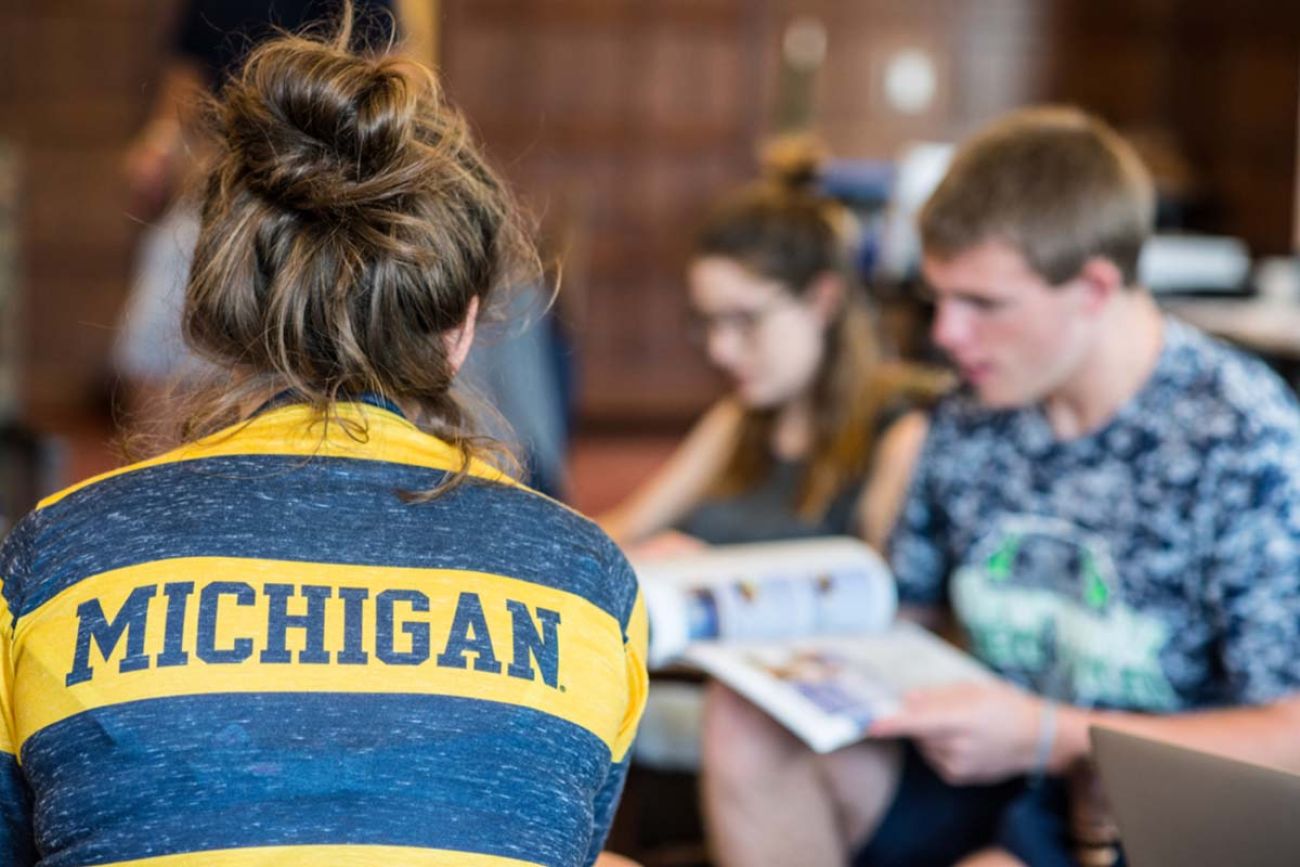U-M gives AI assistant to every student. Environmental worries follow

The University of Michigan is touting itself as the first campus in the world to create its own AI platform for the campus community and continues to expand its artificial intelligence tools. But officials don’t know exactly what the environmental impact of it all will be.
In September, the university announced that each of its students – more than 52,000 – would be given a personal AI assistant, adding to the school’s host of generative AI tools created in partnership with Microsoft. The tools are available to all faculty, staff, and students on the Ann Arbor, Flint, and Dearborn campuses and at Michigan Medicine.
September’s email announcement raised concern among some university staff and students about the environmental footprint of the university’s increasing use of AI.
AI can have environmental impacts that range from increased carbon emissions, vast water and energy usage to power, cool and maintain the data centers that underpin the technology, and more electronic waste – although the exact extent of the impact is not easy to measure. Some estimates suggest that generative AI uses 33 times as much energy to complete a task as traditional software, and it takes more than a bottle of water to generate one email.
Related:
- Excited but worried, Michigan teachers wrestle with artificial intelligence
- After shooting, MSU adding AI surveillance to detect threats, count people
- How AI is altering health care in Michigan
The same week the September email was sent, it was announced that operations at Three Mile Island, the site of the worst nuclear disaster in U.S. history, would restart in order to power Microsoft data centers.
UM’s Vice President of Information Technology and Chief Information Officer, Ravi Pendse, said the university’s environmental goals to address the climate crisis were considered in developing its AI tools. Yet he said his office doesn’t know exactly what the environmental impact of their AI platform is.

“I’m not sure that they’re being counted in school emissions, because frankly all the AI queries that students are doing are not running on our data centers,” he said. “We are very focused on the University of Michigan’s environmental and sustainability goals and we are going to continue to focus on it and support it in every way we can.”
Pendse said the university chose Microsoft as its partner because of its commitment to becoming zero waste and carbon-negative by 2030. According to its website, the corporation plans to offset all of the emissions created since the company’s 1975 founding by 2050.
The corporation also plans to return more water to stressed basins globally than it uses by 2030. Some estimates suggest that Microsoft’s footprint could reach 50 million gallons of drinking water per year to cool its growing number of data centers. It currently operates more than 300 of them around the world.
Microsoft declined to comment on the energy used to power UM’s AI platform.
“We want to make sure that we’re only partnering with vendors who align with our sustainability values and goals,” he said. But he pushed back against students’’ calls to forgo AI use to protect the environment.
“Why not just not use AI? Just turn everything off and not use AI? That is not an option at one of the top research institutions in the world because AI is here to stay,” Pendse said.

AI isn’t going away
In late September, the Michigan House passed Senate Bill 237, exempting large data centers from use taxes on equipment through 2050. Environmental advocates say the bill could attract more data centers to Michigan, threatening the state’s renewable energy legislation and climate goals.
In a survey across the University of Michigan’s three campuses with more than 6,000 responses, nearly 60% of faculty, undergraduate and graduate students and 40% of staff members indicated they have used generative AI in some form. In the same survey, respondents in all roles described more concerns than potential uses with generative AI and said they wanted more information and training.
Some students and staff felt the September email Pendse sent announcing the university’s new personal AI assistant didn’t share enough about the technology’s social, environmental, and financial concerns. The email notified the UM community that all students would be given a personal AI assistant, MiMaizey, and described ways that the tool could be helpful to students. It concluded with Pendse encouraging people to reach out with questions and concerns.
Annalise Rowe, a senior in the School of Public Health, said the loudest message students hear from the universityabout AI relates to the academic implications of using it to cheat or plagiarize. She said she’s heard nothing about the energy it consumes.
“It’s a challenge between, as students, finding the easiest way through your workload, which just gets heavier and heavier, and also grappling with the fact that you’re kind of destroying the planet every time you [use AI],” said Rowe, who occasionally uses AI for outlines or research. “There’s no warnings that come with it. Most of what we get about AI is the cheating element and not the environmental impact of it.”
Ishana Kalra, a freshman with an undecided major, said it would have been nice if the email had included the potential negative environmental and social implications of AI, how the university made the decision, and what it cost.
“Because then we could’ve said, ‘Oh, we don’t need it if it’s costing this much.’ There wasn’t student feedback on it,” she said.
Kalra said she uses AI tools approximately twice a week for classwork like coding but feels it wasn’t necessary for the university to give each student their own AI assistant.
“There’s enough out there on AI that we have enough generally,” she said. “I don’t see why the university needed to create its own [platform].”
Without detailing specific financials, Pendse said the platform wasn’t “inexpensive.” Six full-time employees work on UM’s AI, which operates on a “pay-as-you-go” model, where the university is billed for each query made using the platform.
Sophomore and ecology and evolutionary biology major Hailey Storey said she’d rather the school spend money on more research opportunities or tutors for language courses, which many Michigan students must take to complete their foreign language degree requirements.
Haelee Christmas, a junior political science major, said she’s never used the Michigan AI tools and that most of her classmates use other AI platforms.
“I felt like Michigan was just trying to have one more thing,” she said. “With ChatGPT, that’s usually what students are using to help with their classes anyway.”
Christman said she didn’t know there was an environmental impact from using AI.

An education on campus
Alex Bryan, director of student life sustainability at the University of Michigan, said that in his daily interactions with students and staff across the campus community, “rarely” do people understand the environmental impacts of AI.
“There is a significant opportunity for transformative change using these tools and new methods of machine learning. And it doesn’t come without a cost,” he said. “When we make these tools ubiquitously available to our students without sharing some information about the environmental costs of those tools, it makes me a little nervous.
Bryan said he would like more education surrounding use of the technology, similar to how the university’s dining halls started labeling foods with carbon footprint icons indicating how carbon-intensive they are.
He said emissions from the school’s AI platform would “certainly” be considered under Scope 3 emissions tracking. Scope 3 emissions are a category of greenhouse gas emissions that result from activities the university is involved with but not directly in control of, like commuting and waste disposal. UM is currently setting goals for mitigating Scope 3 emissions, which will be implemented by 2025.
Pendse noted that ChatGPT, a significant development in AI history, is only two years old and that AI systems will become more sustainable and efficient as they are refined over time. Pendse said the university’s use is miniscule at the moment.
“Our use, as we have seen, is so minuscule compared to what happens in Microsoft data centers that I think the University of Michigan’s use doesn’t even register on their meters,” he said.
However, Pendse said the criticism of not including environmental implications in September’s email was “a fair point” and that if MiMaizey is released from beta and becomes a real product, the university would highlight the environmental implications.
“AI, in my opinion, is going to be one of the most impactful technologies and force for positive disruption, if used responsibly, if used ethically, and if used thoughtfully,” he said. “That responsible and thoughtful use, in my mind, must include conversation about [the]impact of these AI tools on our environment.”
Michigan Environment Watch
Michigan Environment Watch examines how public policy, industry, and other factors interact with the state’s trove of natural resources.
- See full coverage
- Subscribe
- Share tips and questions with Bridge environment reporter Kelly House
Michigan Environment Watch is made possible by generous financial support from:
Our generous Environment Watch underwriters encourage Bridge Michigan readers to also support civic journalism by becoming Bridge members. Please consider joining today.
See what new members are saying about why they donated to Bridge Michigan:
- “In order for this information to be accurate and unbiased it must be underwritten by its readers, not by special interests.” - Larry S.
- “Not many other media sources report on the topics Bridge does.” - Susan B.
- “Your journalism is outstanding and rare these days.” - Mark S.
If you want to ensure the future of nonpartisan, nonprofit Michigan journalism, please become a member today. You, too, will be asked why you donated and maybe we'll feature your quote next time!






